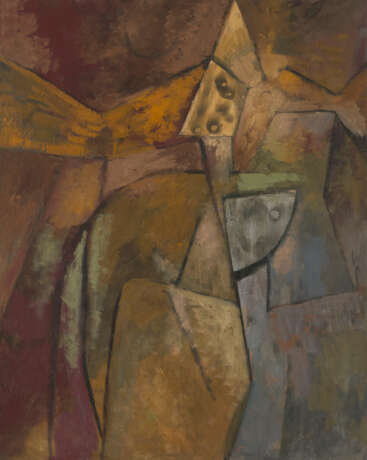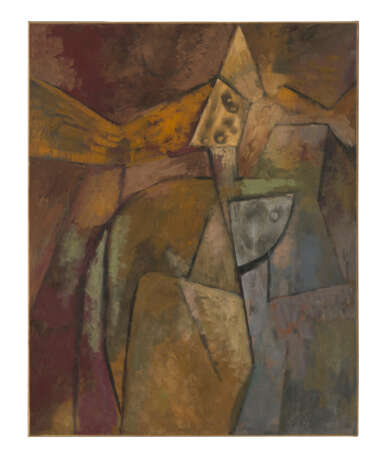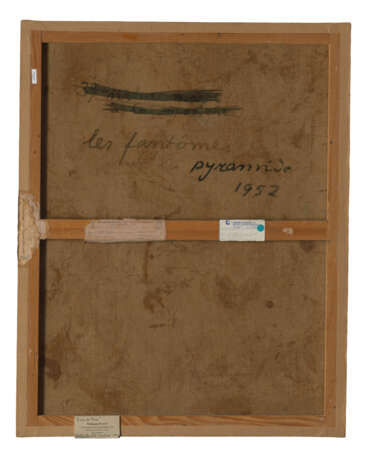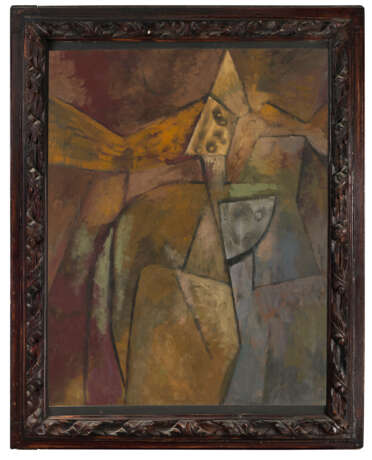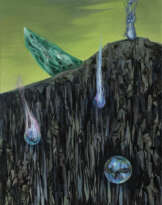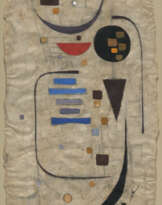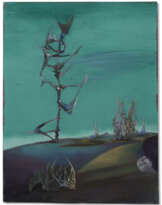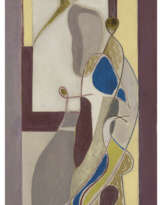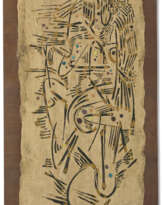ID 1302076
Lot 48 | Wolfgang Paalen (1905-1959)
Estimate value
€ 50 000 – 70 000
Les Fantômes de la pyramide
signé des initiales 'WP' (au centre à droite); daté et inscrit 'les fantômes de la pyramide 1952' (au revers)
huile et fumage sur toile
92 x 73.3 cm.
Peint en 1952
signed with the initials ‘WP’ (centre right); dated and inscribed 'les fantômes de la pyramide 1952' (on the reverse)
oil and fumage on canvas
36 ¼ x 28 7/8 in.
Painted in 1952
Provenance
Dr. Milton Arno Leof, Mexico (avant 1967).
Galerie des Quatre Mouvements (Marcel Fleiss), Paris.
Acquis auprès de celle-ci en mars 1972.
Literature
J. Pierre, Wolfgang Paalen, Paris, 1980, p. 79 (illustré en couleurs, p. 51).
A. Neufert, Wolfgang Paalen, Im Inneren des Wals, Monografie-Schriften-Œuvrekatalog, New York et Vienne, 1999, p. 328, no. 52.04 (illustré).
Exhibited
Mexico, Museo de Arte Moderno, Hommage to Wolfgang Paalen, septembre-octobre 1967 (hors catalogue).
Paris, Musée d'Art Moderne de la Ville de Paris, Passions privées, Collections particulières d'art moderne et contemporain en France, décembre 1995-mars 1996, p. 222, no. A18.8 (illustré, p. 223).
Toulouse, Espace d'Art Moderne et Contemporain, Prises de Terre, Potlatch pour Noël Arnaud, novembre-décembre 1997, p. 42 (illustré en couleurs, p. 31).
Further Details
L'Autrichien Wolfgang Paalen s'est associé au courant surréaliste à diverses étapes de sa trajectoire artistique en Europe, au Mexique et aux États-Unis. Sa première contribution majeure au mouvement remonte à l'Exposition internationale du surréalisme, qu'il co-organise en 1938 à la galerie des Beaux-Arts, à Paris. À cette occasion, il se joint notamment à Marcel Duchamp, Salvador Dalí et Man Ray dans la conception de l'un des tout premiers « environnements » (ou « installations ») de l'histoire de l'art. Paalen réalise dans le cadre de cette œuvre collective une créature totémique à partir d'un mannequin de vitrine, qu'il recouvre d'un assemblage de champignons et de plantes grimpantes évoquant les forces de la nature et leurs mystères, thèmes qu'il approfondira dans ses travaux ultérieurs. Meurtri par les drames et les deuils de son enfance, Paalen cherchera tout au long de sa carrière à dialoguer avec l'invisible et rendre manifeste l'ineffable, en employant différents procédés dérivés des expériences automatiques des surréalistes. Parmi ses inventions les plus marquantes : le « fumage », une technique consistant à passer du papier ou de la toile sur la flamme d'une bougie, pour que la fumée y dépose un ensemble de traces évanescentes. Avec ses pinceaux et ses couleurs, Paalen retravaille ensuite ces formes aléatoires afin de créer un réseau insondable de touches, de volutes et de tourbillons. En découle une expression aux accents médiumniques, comme habitée par des puissances telluriques.
Paalen s'installe en 1939 à Mexico avec son épouse, la poétesse et peintre Alice Rahon. Accompagnés de leur amie et mécène Eva Sulzer, photographe suisse, ils trouvent grâce à Diego Rivera et Frida Kahlo une demeure dans le quartier de ces derniers, à Coyoacán. En 1940, avec le soutien de son ami André Breton (resté à Paris) et du poète péruvien César Moro, Paalen monte la fameuse Exposition internationale du surréalisme à la Galería de Arte Mexicano, fondée par Inés Amor. Il reçoit durant cette période la visite de nombreux artistes dont Roberto Matta, Gordon Onslow Ford et Robert Motherwell, ainsi que Remedios Varo et son compagnon Benjamin Péret, lesquels s'établissent bientôt au Mexique à leur tour. Au printemps 1942, Paalen lance la revue d'art DYN : les cinq numéros qui voient le jour entre 1942 et 1944 lui permettent de diffuser son intérêt pour des thématiques aussi variées que la physique quantique, le totémisme ou l'art rupestre, tout en explorant des sujets plus politiques comme le matérialisme dialectique. Publication influente, très appréciée de la génération émergente des expressionnistes abstraits new-yorkais, DYN assoit la réputation de Paalen comme penseur et théoricien novateur.
En 1952, Paalen regagne Paris, cherchant peut-être à se réconcilier avec les surréalistes dont il s'était brutalement éloigné après avoir signé un article fracassant, Farewell to surrealism, dans le premier numéro de DYN. Il loue la demeure de Kurt Seligmann à la Villa Seurat et renoue rapidement avec Breton, qui l'invite à passer les beaux jours dans le charme médiéval de Saint-Cirq-Lapopie, avant son retour définitif au Mexique en 1954.
Paalen peint durant ce séjour en France un certain nombre de toiles magistrales, marquées par une expression abstraite d'une grande virtuosité. C'est dans ce contexte qu'il exécute Les Fantômes de la pyramide (1952), en s'appuyant sur l'emblématique procédé de « fumage » qui irrigue l'ensemble de son œuvre. Les taches et points vaporeux semblent traduire ici l'idée de la course du temps, nous plongeant dans un monde de secrets archaïques, de souvenirs nébuleux. En 1959, sept ans après la réalisation de cette toile, Paalen se donne la mort à l'âge de 54 ans, mettant hélas fin à un important chapitre de l'aventure surréaliste.
The Austrian artist Wolfgang Paalen was involved with the Surrealist movement off and on in Europe, Mexico and the United States. His first serious participation with the group came in 1938 when he became involved with the design for the International Exhibition of Surrealism at the Palais de Beaux Arts in Paris. There, with Marcel Duchamp, Salvador Dalí and Man Ray he helped to create one of the first art “environments” or what are known today as “installations”. The mannequin Paalen decorated resembled a totemic entity covered with vines and mushrooms that evoked the mysterious forces of nature, themes his work would take up later with greater intensity. Struggling under the burden of traumatic loss in childhood, Paalen sought to contact and make visible otherworldly dimensions utilizing a variety of techniques related to Surrealism’s use of psychic automatism. One of his greatest innovations was the development and use of what he termed “fumage” or “smoke” paintings that were created by passing paper or canvas over a candle flame that left flickering smoky traces. Paalen would then build upon these random markings, adding colors and brushstrokes to create ephemeral whirlwinds that resemble mediumistic channelings of telluric forces.
With his wife, the poet and later painter Alice Rahon, Paalen moved to Mexico in 1939, accompanied by their friend and benefactor, the Swiss photographer Eva Sulzer. With the help of Diego Rivera and his wife Frida Kahlo, they settled nearby in the Coyoacán neighborhood of Mexico City. In 1940, with the assistance of the Peruvian poet César Moro and his friend André Breton (who remained in Paris) he opened the now legendary International Surrealist Exhibition at the Galería de Arte Mexicano founded by Inés Amor. While in Mexico he housed artist visitors such as Roberto Matta, Gordon Onslow Ford, and Robert Motherwell as well as Remedios Varo and her partner Benjamin Péret, both of whom would later settle in Mexico. In spring of 1942 Paalen launched an art journal titled DYN that published five issues between 1942 and 1944. He used this journal to express his interests in a variety of subjects such as quantum theory, totemism, and cave painting, in addition to more political topics including dialectical materialism. Extremely influential, especially to the developing generation of Abstract Expressionist artists in New York, DYN established Paalen’s reputation as an innovative thinker and theorist.
In 1952 Paalen returned to Paris, perhaps to reconcile with the Surrealists with whom he had broken off contact after his scandalous essay “Farewell to Surrealism” published in the first issue of DYN. Renting Kurt Seligmann’s Villa Seurat in Paris, Paalen renewed his relationship with Breton, spending his summers with him at his house in the charming medieval town of Saint-Cirq-Lapopie, before returning to Mexico in 1954.
During his stay in France he painted a number of masterful canvases that display a virtuoso abstract pictorial language. It was during this time that Paalen painted the 1952 Les Fantômes de la pyramide, utilizing the fumage technique he invented and used throughout his artistic career. The smoky dots and smudges of the fumage convey a sense of the passage of time, the mystery of the archaic and even the random nature of memory itself. Only seven years later in 1959, at the age of 54, Paalen committed suicide in Mexico, sadly bringing to an end an important chapter in the history of Surrealism.
| Artist: | Wolfgang Paalen (1905 - 1959) |
|---|---|
| Applied technique: | Oil on canvas |
| Auction house category: | Paintings, Watercolors, Drawings, Paintings |
| Artist: | Wolfgang Paalen (1905 - 1959) |
|---|---|
| Applied technique: | Oil on canvas |
| Auction house category: | Paintings, Watercolors, Drawings, Paintings |
| Address of auction |
CHRISTIE'S 8 King Street, St. James's SW1Y 6QT London United Kingdom | |
|---|---|---|
| Preview |
| |
| Phone | +44 (0)20 7839 9060 | |
| Buyer Premium | see on Website | |
| Conditions of purchase | Conditions of purchase |
